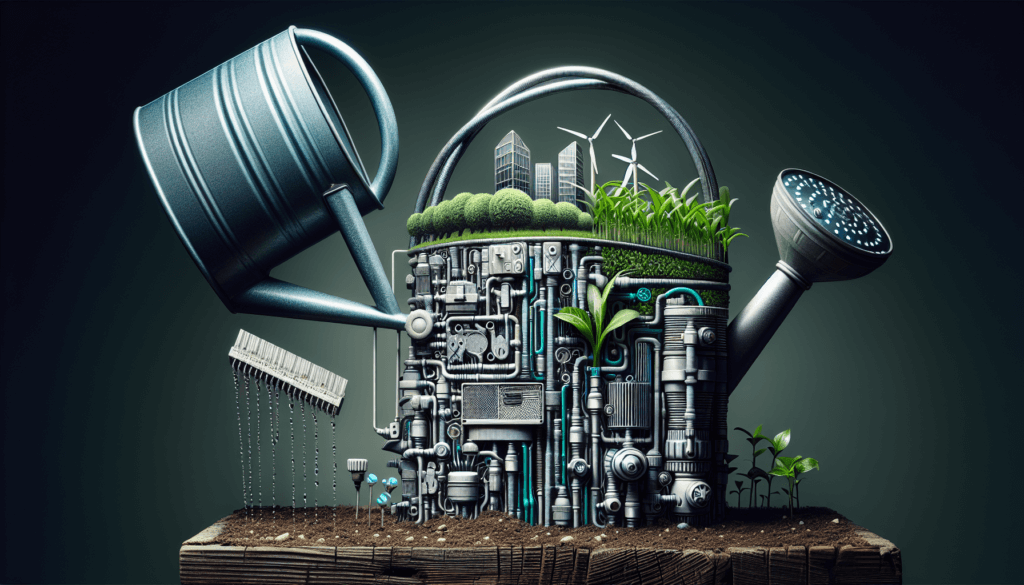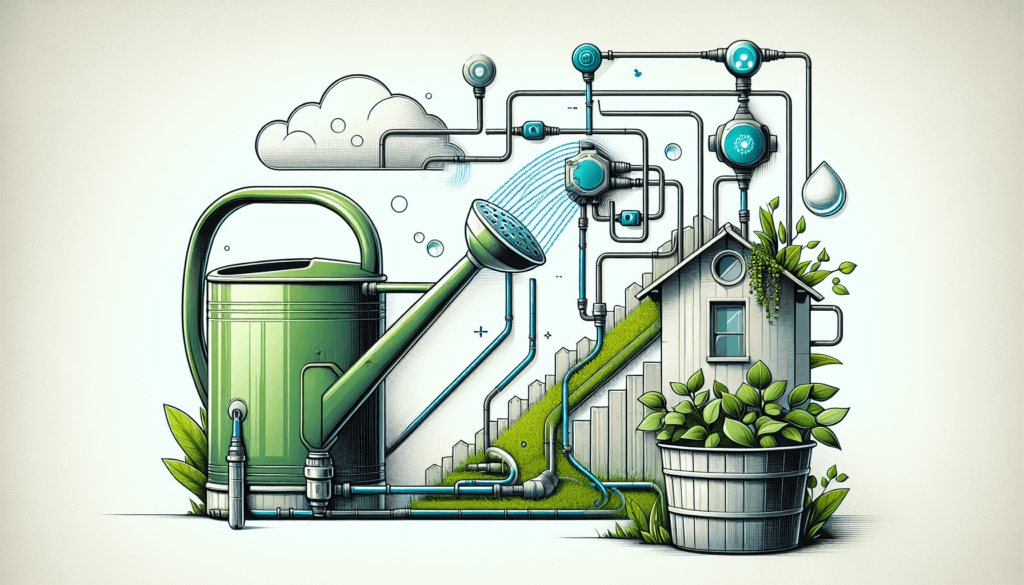You know how important it is to keep your urban garden thriving, but sometimes finding the time to water all your plants can be a challenge. That’s where DIY irrigation systems come in. With a few simple materials and a little bit of creativity, you can set up your own efficient and cost-effective irrigation system that will keep your plants hydrated and healthy. In this article, we will explore different DIY irrigation systems that you can easily build for your urban garden, saving you time and ensuring your plants get the water they need.

Choosing the Right Irrigation System
When it comes to irrigating your urban garden, there are several options to choose from. Each irrigation system has its own advantages and disadvantages, so it’s important to consider your specific needs and requirements before making a decision. Here are some popular irrigation systems to consider:
Drip Irrigation
Drip irrigation is a highly efficient and water-saving system that delivers water directly to the roots of plants. This system uses a network of tubes with small emitters that slowly release water into the soil. Drip irrigation is perfect for gardens with plants that have different water requirements, as you can easily adjust the flow rate of each emitter. It is also a great option for conserving water in dry climates or areas with water restrictions.
Sprinkler Systems
Sprinkler systems are one of the most common types of irrigation systems used in urban gardens. They consist of sprinkler heads that spray water over a large area. Sprinkler systems are easy to install and can cover a wide range of vegetation. However, they are not the most efficient watering method, as water can be easily lost to evaporation and wind. It is important to use sprinkler heads that are adjustable in order to avoid watering non-vegetated areas such as pavement or buildings.
Soaker Hoses
Soaker hoses are a simple and cost-effective irrigation system that delivers water directly to the base of your plants. These hoses have tiny pores that allow water to seep out slowly and evenly along the length of the hose. Soaker hoses are a great option for gardens with raised beds or closely spaced plants. They are easy to install and can be placed under a layer of mulch to prevent water evaporation.
Micro-Sprinklers
Micro-sprinklers are similar to traditional sprinkler systems, but they use smaller sprinkler heads that cover a smaller area. They are often used in gardens with a variety of plant sizes or in raised beds. Micro-sprinklers provide great coverage, but they are more prone to clogging and can be less water-efficient than other systems.
Calculating Water Needs
Before setting up your irrigation system, it’s important to calculate your garden’s water needs. This will help you determine the appropriate size and type of irrigation system for your urban garden.
Determining Garden Size
To calculate your garden size, measure the length and width of your garden beds or designated planting areas. Multiply these measurements to find the total square footage. If you have irregular-shaped beds, divide them into smaller sections and calculate the square footage for each section separately. Add up these measurements to determine the total garden size.
Calculating Water Requirements
After determining your garden size, you need to calculate the water requirements of your plants. Different plants have different water needs, which can vary based on factors like climate, plant type, and stage of growth. Research the specific water requirements of your plants and estimate the amount of water needed per week.
To calculate the total water requirement for your garden, multiply the water needs per week by the number of plants. Add together the water requirements for each plant to determine the total weekly water requirement for your garden. This will give you an idea of how much water your irrigation system needs to deliver.
Gathering the Necessary Tools and Supplies
Before you start installing your irrigation system, it’s important to gather all the necessary tools and supplies. Having everything ready will make the installation process smoother and more efficient.
Tools
Some common tools you will need for installing an irrigation system include:
- Shovel or garden spade for digging trenches and holes
- Tape measure for measuring distances
- Pipe cutter or hacksaw for cutting pipes
- Adjustable wrench or pliers for tightening fittings
- Hole punch for installing emitters
- Screwdriver for connecting timers or controllers
- Wire cutters for cutting wires
Make sure these tools are readily available before starting the installation process.
Supplies
In addition to tools, you will also need various supplies for your irrigation system installation. These supplies include:
- Irrigation pipes or hoses: Choose pipes or hoses that are suitable for your specific irrigation system. Consider factors like durability, flexibility, and compatibility with fittings.
- Connectors and fittings: You will need connectors and fittings to join pipes or hoses together, as well as to connect them to other components of the system.
- Emitters: Depending on the type of irrigation system you choose, you may need emitters like drippers or sprinkler heads to deliver water to your plants.
- Timer or controller: A timer or controller is essential for automating your irrigation system. It allows you to program watering schedules and ensures consistent and efficient watering.
- Mulch: Consider adding mulch to your garden beds to help retain moisture and reduce water evaporation.
By gathering all the necessary tools and supplies, you will be well-prepared to install your irrigation system efficiently and effectively.
Designing the Layout
Designing the layout of your irrigation system is an important step to ensure effective water distribution throughout your garden.
Mapping out the Garden
Before installing any pipes or hoses, it’s helpful to map out your garden on paper. This will give you a visual representation of your garden and help you plan the placement of pipes or hoses and emitters. Consider the layout of your garden beds, the location of plants, and any other obstacles or features you need to work around.
Mark the key components of your garden on the map, such as water sources, main water line installation points, and emitter locations. This will help you visualize the flow of water and identify any potential challenges or adjustments needed.
Identifying Water Sources
Next, identify the water sources available for your irrigation system. This could be a tap or faucet, rainwater tank, or even a well. Ensure that the water source is easily accessible and can provide sufficient water for your garden’s needs.
Consider the proximity of the water source to your garden and plan the layout accordingly. If your water source is far away, you may need to use longer pipes or hoses and consider the pressure requirements of your irrigation system.
Determining Pipe and Hose Lengths
Once you have mapped out your garden and identified the water sources, you can determine the lengths of pipes or hoses needed for your irrigation system. Measure the distance from the water source to the farthest point in your garden, taking into account the layout and any obstacles you need to work around.
Opt for slightly longer pipes or hoses to allow for flexibility and adjustments during the installation process. It’s easier to trim excess length than to add more later if needed.
By carefully designing the layout of your irrigation system, you can ensure efficient water distribution and avoid any potential issues down the line.

Installing the Main Water Line
The main water line is a crucial component of your irrigation system as it delivers water from the water source to the distribution system. Proper installation of the main water line is essential for the overall functionality and performance of your system.
Choosing the Right Pipe
When selecting a pipe for your main water line, consider factors like durability, flexibility, and compatibility with fittings. PVC (polyvinyl chloride) pipes are a common choice for irrigation systems as they are affordable, easy to work with, and resistant to corrosion.
Ensure that the pipe diameter is appropriate for the flow rate and pressure of your system. Smaller diameter pipes can cause a decrease in water pressure, while larger diameter pipes may not provide sufficient pressure for your system to function optimally.
Connecting to a Water Source
To connect your main water line to the water source, you will need a suitable connector or fitting. This will depend on the type of water source you have and the specific irrigation system you are installing.
For taps or faucets, you can use a garden hose connector that allows you to attach the pipe securely. If you are connecting to a rainwater tank or another water source, make sure to choose a fitting that is compatible with the source and ensures a watertight connection.
Ensure that the connection is secure and free from leaks. A leaking connection can cause water waste and negatively impact the performance of your irrigation system.
Installing the Main Line
To install the main water line, start by digging a trench that runs from the water source to the point where you will connect the distribution system. The trench should be deep enough to bury the pipe and provide protection against damage.
Lay the pipe in the trench, making sure it is straight and properly aligned with the distribution system’s connection point. Secure the pipe with stakes or brackets to prevent movement or shifting.
Once the pipe is in place, backfill the trench with soil, ensuring that there are no sharp objects or rocks that could damage the pipe. Compact the soil gently to create a stable base for the main water line.
By choosing the right pipe, making secure connections, and properly installing the main water line, you can ensure a reliable and efficient water supply for your irrigation system.
Installing the Distribution System
The distribution system is responsible for delivering water from the main water line to your plants. Installing this system correctly is crucial for ensuring even and efficient water distribution throughout your garden.
Laying Pipes or Hoses
The first step in installing the distribution system is to lay the pipes or hoses. Start at the connection point with the main water line and work your way through your garden, following the layout you designed earlier.
If you are using pipes, lay them in the trenches you dug, making sure they are properly aligned and connected with fittings. Ensure that the pipes slope slightly downward towards the emitters to facilitate water flow. Secure the pipes with stakes or brackets to prevent movement or shifting.
If you are using hoses, position them along the designated areas of your garden beds. Secure the hoses with stakes or clips to keep them in place.
Ensure that the pipes or hoses are laid in a way that avoids any potential tripping hazards or damage to plants. Consider using covered trenches or mulch to conceal and protect the distribution system.
Installing Emitters
Once the pipes or hoses are in place, it’s time to install the emitters that will deliver water to your plants. The type of emitters you use will depend on the specific irrigation system you chose.
For drip irrigation systems, attach drippers or micro-sprinklers to the pipes or hoses at the desired locations. Ensure that the flow rate and coverage of the emitters match the water requirements of your plants.
For sprinkler systems, attach sprinkler heads to the pipes and position them at appropriate intervals. Adjust the angle and spray pattern of the sprinkler heads to cover your garden evenly.
Ensure that all emitters are securely attached and free from leaks. A leaking emitter can result in uneven watering and wasted water.
By properly laying the distribution system and installing the emitters correctly, you can ensure efficient water distribution and promote healthy plant growth in your urban garden.

Installing a Timer or Controller
Installing a timer or controller for your irrigation system is a game-changer as it provides automated control over your watering schedule. This saves you time and effort while ensuring consistent and efficient watering.
Choosing the Right Timer
When selecting a timer or controller for your irrigation system, consider your specific needs and preferences. There are various types of timers available, including manual, mechanical, and digital timers.
Manual timers require you to turn them on and off manually. These are budget-friendly options but lack the automation features of other timers.
Mechanical timers use mechanical mechanisms to control the timing and duration of watering. These timers are more reliable and durable but may require occasional manual adjustments.
Digital timers are the most advanced option, offering programmable schedules and multiple watering zones. They allow you to set specific watering times and durations, making them highly customizable and efficient.
Choose a timer that suits your needs and provides the level of automation you desire for your irrigation system.
Wiring the Timer
If you have opted for a digital timer, you will need to connect it to a power source and wire it to the valves or solenoids that control the flow of water. Follow the manufacturer’s instructions for wiring the timer correctly.
Ensure that all electrical connections are secure and free from damage. If you are unsure about working with electricity, consult a professional to ensure a safe and proper installation.
Programming the Timer
Once the timer is wired and connected, it’s time to program it according to your desired watering schedule. Follow the instructions provided with the timer to set the start time, duration, and frequency of watering.
Consider the water requirements of your plants and adjust the watering schedule accordingly. Be mindful of any water restrictions in your area and aim to maximize water efficiency.
Regularly review and update the watering schedule as needed. Factors like seasonal changes, weather conditions, and plant growth can affect the watering needs of your garden.
By installing a timer or controller, you can simplify the management of your irrigation system and ensure consistent and efficient watering for your urban garden.
Testing and Adjusting the System
After installing your irrigation system, it’s important to test and adjust it to ensure optimal performance. Regular testing and adjustment will help you identify any issues or inefficiencies and address them promptly.
Checking for Leaks
Once the system is installed and the water is flowing, inspect all connections, fittings, and emitters for any signs of leaks. Even small leaks can lead to water waste and reduce the overall efficiency of your irrigation system.
Fix any leaks you find by tightening connections or replacing faulty components. Ensure that all components are properly sealed and watertight.
Calibrating Emitters
To ensure even and efficient water distribution, it’s important to calibrate the emitters. This involves adjusting the flow rate and coverage of each emitter to match the water requirements of your plants.
Check the flow rate of the emitters using a flow meter or by collecting water for a set time period. Adjust the emitter’s flow rate if needed by turning the flow control valve or using emitter-specific adjustment mechanisms.
Also, observe the coverage of each emitter and adjust the position or angle if necessary to ensure uniform watering. Observe the water distribution patterns and make any necessary adjustments to improve coverage.
Adjusting Watering Schedule
Regularly review and adjust your watering schedule to account for changing weather conditions, plant growth, and water requirements. Be flexible and responsive to the needs of your plants and aim to maximize water efficiency.
Consider factors like rainfall, temperature, and soil moisture content to determine the appropriate watering frequency and duration. Avoid overwatering or underwatering your plants by monitoring their health and responding accordingly.
By testing and adjusting your irrigation system, you can ensure it is working optimally and providing your plants with the right amount of water.

Maintaining the System
Regular maintenance is essential to keep your irrigation system in good working condition and prolong its lifespan. By implementing a maintenance routine, you can prevent issues and ensure your system continues to function efficiently.
Regular Inspection
Schedule regular inspections of your irrigation system to identify any damage, leaks, or clogs. Check all components, including pipes, hoses, emitters, and connections, for signs of wear or deterioration.
Look for any plant growth that may be obstructing the emitters and clear them if necessary. Remove any debris or dirt that may have accumulated in the system.
Cleaning and Flushing
Periodically clean and flush your irrigation system to remove any buildup of sediment, minerals, or debris that may affect its performance. Follow the manufacturer’s instructions for cleaning and maintenance, or consult a professional if needed.
Flushing the system is particularly important if you are using well water or water with a high mineral content. Sediment and minerals can accumulate in the pipes or emitters, leading to clogs and reduced water flow.
Winterization
If you live in an area with cold winters, it’s crucial to properly winterize your irrigation system to prevent damage from freezing temperatures. Water left in the system can freeze and expand, causing pipes to crack or fittings to burst.
Before the first freeze, shut off the water supply and drain all water from the pipes, hoses, and emitters. Use compressed air to blow out any remaining water and ensure the system is completely dry.
Cover or insulate exposed pipes or emitters to provide additional protection against freezing temperatures. Consult a professional if you are unsure about winterizing your irrigation system to avoid any potential damage.
By following a regular maintenance routine, you can keep your irrigation system in top shape and ensure it continues to provide efficient watering for your urban garden.
Troubleshooting Common Issues
Even with proper installation and maintenance, irrigation systems may encounter common issues that require troubleshooting. Here are some common issues you may encounter and suggestions on how to address them:
Low Water Pressure
Low water pressure can result in insufficient water reaching your plants. Check for any obstructions or leaks in the system that could be causing a decrease in pressure.
Ensure that the main water line is fully open and that there are no blockages in the pipes or hoses. Clean or replace any clogged emitters that may be restricting water flow.
If the issue persists, contact a professional to assess your water pressure and determine if any adjustments or repairs are needed.
Clogged Emitters
Clogged emitters can cause uneven water distribution and prevent water from reaching your plants. Inspect your emitters regularly and clean or replace any that are clogged or malfunctioning.
Check for mineral deposits or debris that may be blocking the emitters. Use a small pin or needle to clear any clogs, taking care not to damage the emitter.
Consider using filters or screens to prevent debris from entering the system and clogging the emitters. Regularly clean or replace these filters to ensure proper water flow.
Uneven Water Distribution
Uneven water distribution can result in some plants receiving too much water while others receive too little. Inspect the emitters and adjust their positions or angles to improve coverage.
Check for any leaks in the system that may be causing water to escape before reaching the plants. Ensure that all connections and fittings are secure and watertight.
Consider the layout of your garden and adjust the placement of emitters to ensure even coverage. Monitor the water distribution patterns and make any necessary adjustments to promote uniform watering.
By troubleshooting common issues and addressing them promptly, you can ensure that your irrigation system is functioning effectively and providing optimal water distribution for your urban garden.
In conclusion, choosing the right irrigation system for your urban garden is essential for maintaining healthy plants and conserving water. Consider the advantages and disadvantages of each system before making a decision. Calculate the water needs of your garden and gather all the necessary tools and supplies. Design the layout of your irrigation system, install the main water line and distribution system, and connect a timer to automate your watering schedule. Test and adjust the system to ensure proper functionality, and establish a maintenance routine to keep it in good condition. Troubleshoot common issues as they arise to maintain efficient water distribution. By following these steps, you can create a DIY irrigation system that will keep your urban garden thriving.



